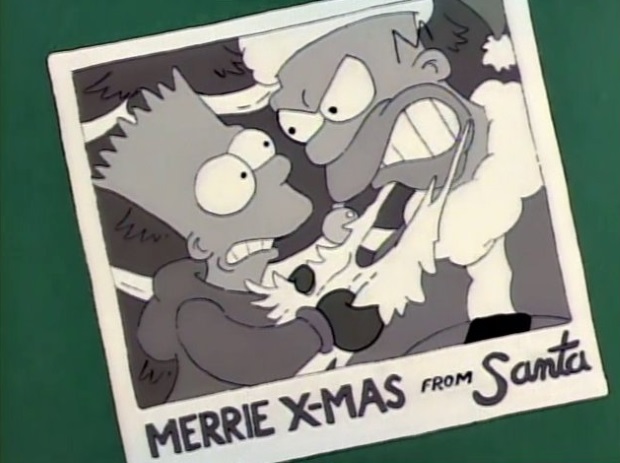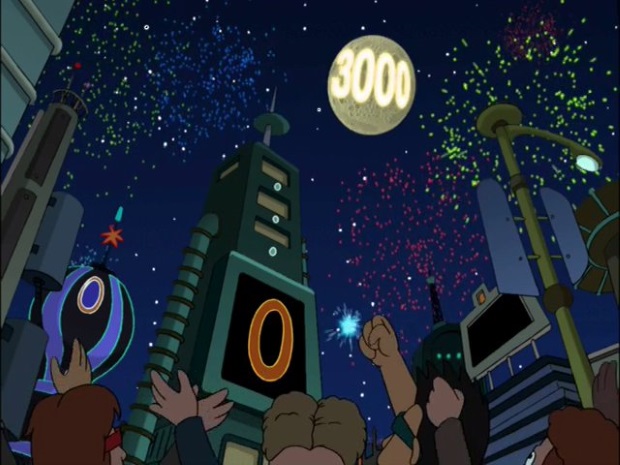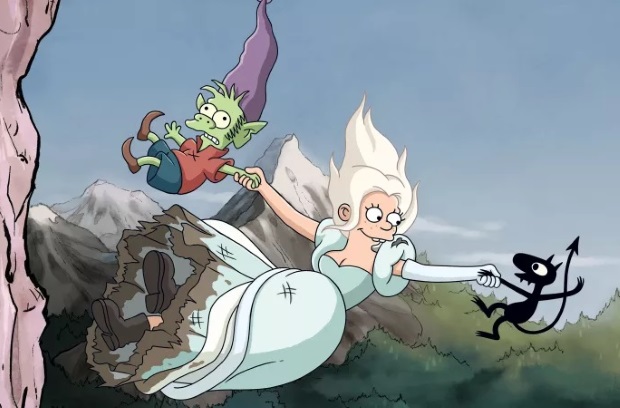Revisiting Matt Groening’s Animated Firsts
The Simpsons, Futurama, and Disenchantment all began with very different pilots...
This article comes from Den of Geek UK.
Warning: contains spoilers for the first episodes of The Simpsons, Futurama, and Disenchantment.
Matt Groening has been meddling with time forever. His latest show, the Netflix Original comedy Disenchantment, is billed as a story from a fantastical past, but his other two shows are similarly unbound by the continuity of live-action shows. Futurama takes place on Earth one thousand years in the future and The Simpsons has become timeless by dint of its longevity, taking an ordinary American family, turning them bright yellow, and playing out their adventures across an almost static thirty-year period.
But all those shows had to start somewhere and it’s interesting to look back at the similarities and differences between series premieres from the same creator across three decades. Working with seasoned network TV writers, all are bound to one extent or another by the traditional three-act structure, but each show has a different kind of emphasis.
Before we get into it, it’s worth pointing out that pilots aren’t typically the same for animated shows as they are for live-action, on account of how costly and time-consuming it can be to produce. Seasons of animated shows are usually ordered in advance, whereas live-action pilots are easier to shoot one at a time.
Despite how only one of the episodes we’re about to discuss was actually conceived as a traditional network TV-style pilot, each episode serves the same function by providing a glimpse of the series. All of these shows, even the simultaneously released first season of Disenchantment, move forward in some way from what’s initially established, whether through character development or a more assertive style. With that in mind, let’s start with the one that was never meant to go first.
Simpsons Roasting On An Open Fire (1989)

“Well, I guess TV has betrayed me.”
Right away, The Simpsons’ first broadcast episode got the show off to an unconventional start. As we’ve mentioned, animated shows don’t really have pilots, but Simpsons Roasting On An Open Fire wasn’t even meant to be the first episode of the series.
Penned by Mimi Pond in her one and only credit on the show, this was actually the eighth episode produced, but due to some teething troubles with the animation process on the fledgeling show, it was the first to be aired. Expanded from Groening’s popular shorts on The Tracey Ullman Show, the series was commissioned by Fox for 13 episodes to begin airing in autumn of 1989.
Ultimately, the show was pushed back after the intended first episode, Some Enchanted Evening, due to producer James L. Brooks’ strong criticism of the overseas animation studio’s work. Some Enchanted Evening, which was written by Groening and Sam Simon, was significantly reworked throughout the remainder of production, and eventually aired as the first season’s finale. With a December 17th start date, the Christmas episode came to the fore.
For the most part, none of this shows in the episode. Marge’s Christmas letter near the start of the episode is such a good way of introducing the family that it’s surprising it wasn’t always meant to be so. The series’ leftfield sensibility is present from the very beginning, with its commentary on how real working class families often don’t get the lucky breaks that their mainstream sitcom counterparts do.
The episode finds the Simpson family facing Christmas with no money, after a mishap involving Bart getting a tattoo wipes out their savings. Unbeknownst to Marge, Mr Burns has cancelled Homer’s Christmas bonus, leading him on a wild goose chase to try and scare up some funds before the 25th rolls around.
It’s a story that’s more prominently about the family’s limited means than most other episodes over the show’s three decades on the air. On the wrong side of the late-1980s income gap, the Simpsons are struggling, and Christmas special or no, there’s no almighty financial windfall to save the day before the half-hour is up.
It’s a striking setup for a seasonal episode, never mind a pilot, and it’s notable that the show wouldn’t go in for another Christmas special until 1995’s Marge Not Be Proud, which similarly foregrounds family over festivities. Groening and Brooks set out to use the animated medium to tell the story of a family who had to deal with the stresses of the real world and had the season gone out in the intended order, it would have eased audiences in more slowly.
Even the later beloved characters we meet here are somewhat more antagonistic of the hard-done-by Homer. Mr Burns, Patty, and Selma arrive pretty much fully formed, but Ned Flanders, for instance, is still in his earliest characterisation as a smug, well-off bloke who lives next door, rather than the excessively lovely neighbourino he became in subsequent seasons. As a whole, the Springfield community seems more hostile in this first glimpse because of the family’s situation.
On the festive front, Act Two drives Homer to moonlight as a shopping mall Santa in his bid to make a bit of extra cash. After going through the drudgery of training sessions and the humiliation of being unbearded by Bart, he makes just $13 after deductions. After losing this pittance at the dog track in Act Three (after a tip by Barney, who’s not yet been positioned as Homer’s lifelong friend but just a drunk he knows), he’s left miserably searching discarded receipts for a winner.
The episode comes to a happy ending with the family’s adoption of Santa’s Little Helper, who presents the first of the show’s many continuity errors by not appearing in any of the subsequent episodes that were supposed to air first. Furthermore, animal rights groups applauded the episode for raising the issue of abandoned race hounds. But make no mistake, it’s a show that starts out on a stronger foot than intended, by showing a family struggling to get by. The episode was Emmy-nominated the following year but lost to another Season One episode, Life In The Fast Lane.
By a quirk of fate, starting the show in the thick of a family crisis lends to the timeless quality that the show has flirted with over the course of its run. The current showrunner Al Jean has previously said that if and when the show comes to an end, the final scene should be set at Christmas with Homer, Marge and Maggie going to see Bart and Lisa in their school pageant, thereby sealing an infinite loop. It would certainly be the neatest way to avoid ever ending the series proper.
Space Pilot 3000 (1999)

“You gotta do what you gotta do.”
Of the three episodes we’re discussing in this piece, Futurama‘s first episode is both the most complex and the most conventional, in terms of TV pilot structure. That it pulls off both so well is only part of the reason why it’s the best bit of telly out of the three. It also happens to be funny as hell, right out of the gate.
In telling the story of a pizza delivery boy who is cryogenically frozen on New Year’s Eve 1999 and awakened on New Year’s Eve 2099, the show has a fair amount of legwork to do. Marvellously, that entire journey takes place in three and a half minutes flat, in the cold open that deftly sets up Fry as a character, as well as his situation, and his ongoing conflict. Even the opening credits barely feel like a pause for breath in a pilot that hits the ground running and never stops.
Groening came up with the concept for Futurama in the mid-1990s and teamed with Simpsons writer David X. Cohen to develop it. Both are co-credited on the script for Space Pilot 3000, an episode which they have freely admitted was difficult to write.
The approach they decided on, telling as much story as possible while laying Easter eggs for later episodes, turned out to be fruitful for both this episode and the countless callbacks over the series’ staggered seven-season run. Aside from being a really entertaining and imaginative half-hour of telly that entices you perfectly into the “WORLD OF TOMORROW” (cheers, Terry), it’s got a classic three-act structure.
Following the cold open, Act One introduces career officer Turanga Leela (named for Louise Jameson’s character in Doctor Who) and confronts Fry with the possibility that he might always be destined to be a delivery boy. Act Two sees Fry go on the run from Leela and meet Bender the robot. Act Three brings all three together as they quit their old lives and become the Planet Express delivery crew.
Fry’s arc, such as it is, takes him from being fed up with his job as a delivery boy to being overjoyed with his job as a delivery boy. The episode begins and ends on different New Year’s Eves, separated by a thousand years, but fills the circular story with plenty of tantalising locales and ideas, like corporate-sponsored suicide booths, the subterranean Old New York, and the Head Museum where a once and future president bristles from inside his jar.
It’s the show’s attention to detail that really stands out from the very beginning, from background sight gags and sci-fi references to the mysterious shadow under the desk when Fry falls backwards into the cryogenics tube, which would eventually be addressed in season 4’s The Why Of Fry. Even though the specifics were never planned in advance, they cleverly manage to set things up for later on, even in such a breathlessly paced story.
There’s really no time to introduce Amy, Hermes, and Zoidberg, all of whom appear in the subsequent episodes, but it’s an episode that makes extremely creative use of its time while following a quite conventional structure. Even going back and rewatching it in light of the following 139 episodes, it feels a vital and adventurous application of Groening and Cohen’s craft.
A Princess, An Elf, And A Demon Walk Into A Bar (2018)

“I might as well give up and accept that I’ll never be anything more than a wealthy queen of a fabulous faraway kingdom.”
As the space ants from Deep Space Homer once said, “Freedom! Horrible horrible freedom!” Unbound from the strictures of network television, Netflix’s original shows are often an outlet for the more self-indulgent side of TV showrunners. Although Disenchantment settles into its groove by the middle of its first season, the 35-minute season premiere feels like an over-extension of the creative freedom afforded by the platform.
In contrast to both The Simpsons and Futurama, Disenchantment‘s plot is serialised to varying extents throughout its run, in a parody of Game Of Thrones that’s set in a fantastical past. Developed by Groening and Josh Weinstein, the show has a season arc that encompasses the first ten episodes, waxing and waning throughout the more continuity-driven exploits.
The fantasy setting has been lampooned many times in the past, but as other reviewers have remarked, the problem with spoofing GoT, at least in this format, is that it’s a show that already has satirical and subversive leanings. It’s a little of the same problem that Scary Movie had in spoofing Wes Craven’s Scream, but it’s more pressing here. The biggest laugh the show gets out of it is a dimwit accidentally impaling his own head on a facsimile of the Iron Throne.
Where Futurama is relentless in bringing its main characters together and sending them off on adventures, “Chapter I” of Disenchantment takes its sweet time introducing the titular princess, elf, and demon. In the kingdom of Dreamland, Bean is a disaffected 20-something single female who happens to be the heir to the throne.
As she argues with her dad over her arranged marriage to a dolt, an elf called Elfo escapes the hidden kingdom where his kind sing and smile and sing and… yeah. She’s also sent a personal demon called Luci as a wedding gift, a shadow-like creature who binds himself to her.
With regard to each of these new arrivals, Bean’s dad King Zøg orders the court wizard to take a sample of the elf’s blood to start working on an elixir of life and we get fleeting cutaways to the Enchantress and Emperor Cloyd watching their demon at work, which come back around later in the season.
There are comic highlights, including Elfo’s first experience of war as he merrily crosses a battlefield between ogres and gnomes and the grand entrance of a Zapp Brannigan-esque prince voiced by Matt Berry, but they’re pulled together like sketches. The reliable structuring of the other more conventional episodes of network TV tends to slide over the extended running time and the story lacks the drive of either of Groening’s previous premieres.
Forming something of a loose two-parter with the next episode For Whom The Pig Oinks, the episode rumbles on to a literal cliffhanger, finishing with our heroes tumbling through the air with no apparent hope of survival. With the luxury of assuming that viewers will try at least one more episode, the first episode is not an especially good proof of concept for the show.
The three acts of Matt Groening
Separated by decades, the first episodes of Matt Groening’s three animated sitcoms are all markedly different from one another, each specialising in one function of either character, story, or world-building. Spanning from the present to the future to the past, each is a product of the time in which they were actually produced, in one way or another.
Simpsons Roasting On An Open Fire is an accidental pilot that stress-tests the animated family’s suitability for primetime telly with a solidly character-driven festive story. Space Pilot 3000 is a meticulously assembled caper, borne from the confidence of golden age Simpsons, that entertainingly sets up better things. And designed for streaming, A Princess, An Elf And A Demon Walk Into A Bar labors over introducing fun characters in a world that portends further plot down the line.
In all of the shows Groening has created, there has been room to grow from the first episode onwards. But nevertheless, all three of those episodes firmly plant the concepts in the audience’s minds, whether they’re invited to tune in next week or just sit and wait for the second instalment to load.